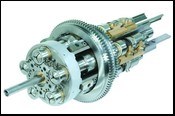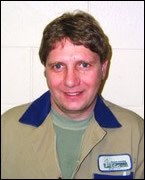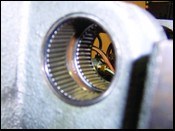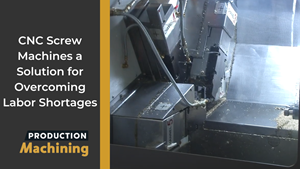Competing On A Multi-Spindle
For many high-volume applications, multi-spindle automatics are the right technology for production machining. Increasingly, that production efficiency has been pressured by changes in the needs of shops in the form of shorter run jobs and higher tolerances. This article looks at some of the steps one OEM has taken to address quick change-over issues on its multi-spindle machines and their tooling.
Back in the day, a screw machine shop was easily defined. Many used multi-spindle automatics of various configurations and capacities to crank out large volumes of relatively uncomplicated parts.
A shop could literally set up a machine and run a job for a year, 2 years and even longer. Such production runs allowed for a high level of fine tuning to the process to get the most efficient production, usually measured in cycle time.
This environment gave rise to the Davenport Model B and many other iconic multi-spindle automatic brands. Today, only a few of those builders are left. Those who have survived have done so by adapting to the changes in the market that uses multi-spindle technology.
Today, high-volume manufacturing includes the need to turn over jobs. Too many jobs are ordered in volumes that are insufficient to dedicate a piece of capital equipment to a single part number. The rub comes to shops and suppliers that have built the business on low-mix, high-volume work. They both must adapt to a new production machining metric.
This article looks at some of the developments that Davenport Machine (Rochester, New York) has implemented in the past few years to help its dedicated customer base adapt and compete using multi-spindles in a market that has dramatically changed. Most of these developments focus on setup reduction and improved accuracies that are keeping this venerable builder and its customers in the game.
Shorter Run Issues
Short jobs are particularly troublesome to most multi-spindle automatic shops for three main reasons. First, the ratio of setup time to run time increases. For example, a typical Davenport job at a contract shop will be in setup for 10 to 18 hours. This is because of the variety in product mix that a contract shop must deal with.
In addition, this setup time must often be spread out over two, three or even four shifts, leading to a chip-to-chip time (the time a machine is not running efficient production) of up to 100 consecutive hours in many cases. In a short-run environment, that can equal or exceed the actual run time of the job, effectively making short-run jobs twice as expensive as long runs.
The second problem that short-run jobs present such a shop is today’s ever tighter Cp and CpK requirements that become more difficult to monitor and hold. It can often take several shifts to determine reliable tool wear trends and anticipate when tool changes are required. Longer runs provide sufficient time to tweak the process. By the time a short-run job is proved and running well, it’s ready to be pulled for the next job.
The third challenge is scheduling. It takes roughly five times as many jobs to keep a machine at capacity than it used to. That is five times as many jobs to schedule, and five times as many customers to keep supplied and happy.
Tooling Plays A Big Role
Implementation of quick-change tooling strategies can help a shop manage these problems. In the case of Davenport, a tooling company (C.J. Winter Machine Technologies) is part of its corporation. With both companies applying their resources into a co-engineered product development focus for the last 3 years, many of their customers have been more competitive in a market increasingly driven to short runs and “traditional” single-spindle work. In real world metalworking, quick-change tooling applied to the company’s multi-spindle machines can reduce chip-to-chip times from up to 100 hours to fewer than 10. By cutting setup times to less than 10 hours, most setups can now be accomplished in less than one shift. That’s 90 hours of extra production out of the equipment already on the floor and with a labor force already on the payroll.
Quick-change tooling also allows machine operators to quickly change to sharp tooling more often, without the hassle of readjusting taper, tool alignment and size. That keeps part tolerances tighter and helps achieve the tighter Cp and CpK values without the necessity of learning tool wear trends. Moreover, with comparatively short one-shift setups, and 90 extra hours of production per setup, job mix flexibility has increased, and a major obstacle to scheduling short-run jobs has been removed.
Internal And External Setups
An immediate advantage to the shop that applies quick-change tooling as part of its setup and production strategy is an ability to begin the setup process for the next part run while the machine tool is making parts for the previous job. In a quick-change strategy, job change-over is broken down into internal and external steps. Internal steps are those that must happen while the machine is turned off and not making parts. External steps are those that can be accomplished while the machine is producing product. A principle of Lean Manufacturing, especially as it applies to setup deduction, is that external actions are considerably less expensive than internal actions. The features engineered into quick-change tooling allow an operator to take many actions that previously could only be done internally to a setup and make them external.
Some of these actions include tool mounting, tool alignment between positions, taper and centerline adjustment and size. All can be preset before shutting off the machine from the prior run. During longer runs, sharp tooling can be preset in spare holders to replace worn tooling with minimal or no adjustment made to the machine. This saves operator and machine time and increases the efficiency of the job’s run.
Making A Better Multi
As the tooling division has developed quick-change tool strategies, the machine tool division has addressed several critical issues on its multi-spindles. The goal of these developments is to enable the company’s traditional customer base to move into new areas of production that were previously unthinkable for these multi-spindle shops.
An example is the new high-precision head being applied to the Servo B models. Any multi-spindle must have an accurate and rigid spindle carrying head. On these new machine models, replacing bronze or needle bearings with angular contact radial bearings has reduced runout for the spindles to consistently less than 0.0005 inch. Jobs thought impossible for the Davenport, such as 52100 bearing steel parts, are now running on these new machines because of the increased rigidity provided by the bearing upgrade.
Applying servomotor technology has enabled all of the clutches and brakes to be replaced with maintenance-free motors provided for a simplified gear train. Spindle speeds, index and cycle times can be changed instantly without spindle change gears, belts or pulleys, cutting setup times substantially. In threading operations, the speed adjustability of the servomotor helps produce better threads with less fuss.
Quick-change tool spindle boxes eliminate the need to realign the spindles and help reduce tool spindle change-over from 1 hour to less than 5 minutes. Needle bearing tool arm studs increase the useful life of swing arm tooling and reduce chatter. A similar needle bearing setup does the same for the backside countersink attachment. A two-position servo backworking attachment allows more complex parts to be dropped off complete, without the need for secondary machining.
Lowering The Volume
The process flexibility and speed of multi-spindle automatics is well understood. They are the original multitasking machine tool technology. According to the company, a Davenport machine can form, shave, drill, ream, backwork, cross mill, cross drill (multiple holes at various timed positions), thread roll, burnish, stamp, flat generate, slot, broach, swage, keyway mill, gear hob, thread mill and more.
The increased efficiency enjoyed by a shop using a quick-change tooling strategy coupled with the machine enhancements on the Davenport will allow them to compete in short and medium job run markets that require 5,000 to 75,000 parts. These market segments were recently considered unprofitable on a multi-spindle because of the excessive cost of 18-hour setup times and 100 hours of lost production for every change-over.
With single-shift setups now possible, multi-spindles can compete. Parts will typically be complete, deburred and ready for shipping. No secondary machining work is required on most of the parts produced.
Related Content
Video Tech Brief: CNC Screw Machines a Solution for Overcoming Labor Shortages
CNC screw machines can exceed job shop productivity and enable manufacturers to overcome perpetual employment gaps.
Read MoreStriving for Faster Changeovers for Multispindles
A multispindle platform designed to combine the high production speed of a cam-driven machine with the precision and repeatability of CNC also includes technology to speed set ups for new jobs.
Read MoreUpgrading Bar Feeder Components with Metal 3D Printing
Index is exploring redesigning and optimizing parts for bar feeders inside its multi-spindle turning centers using a low-cost metal 3D printing platform from One Click Metal.
Read MoreAccessory Speeds Centering Align Drills on CNC Multi-Spindles
The CenterMaster accessory is designed to streamline the setup and changeover process for CNC multi-spindle lathes.
Read MoreRead Next
Pipe Fittings Produced In A Single Operation
As with many manufacturers today, streamlining production to stay competitive in the global market has become increasingly important at this company. Thatýs why it sought out a machine to produce a double-ended pipe fitting in a single operation as opposed to having to do the back-tapping in an entire second operation.
Read MoreEmerging Leaders Nominations Now Open
Here’s your chance to highlight a young person in your manufacturing business who is on the path to be a future leader moving your company forward.
Read MoreA Tooling Workshop Worth a Visit
Marubeni Citizen-Cincom’s tooling and accessory workshop offers a chance to learn more about ancillary devices that can boost machining efficiency and capability.
Read More












.jpg;maxWidth=300;quality=90)



.jpg;maxWidth=300;quality=90)









